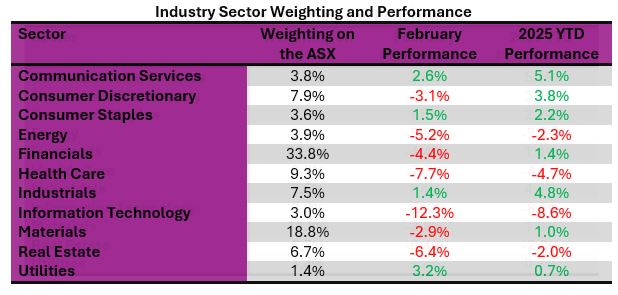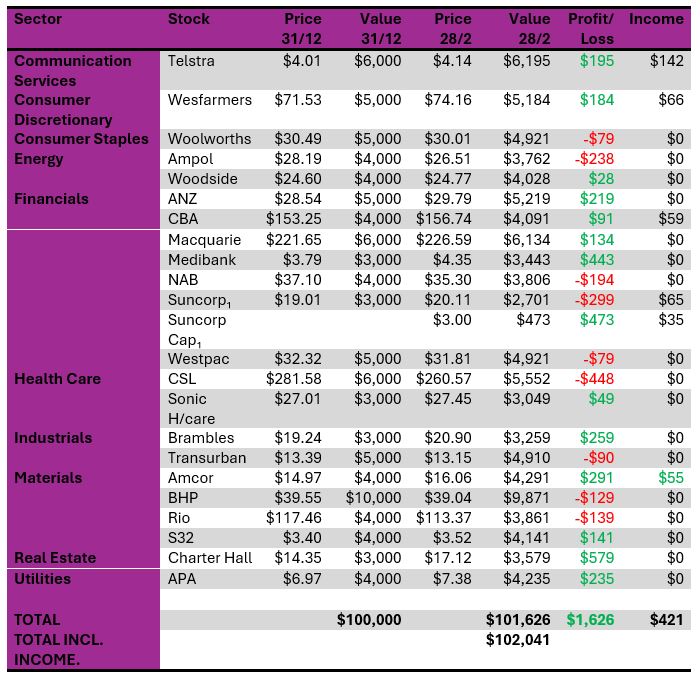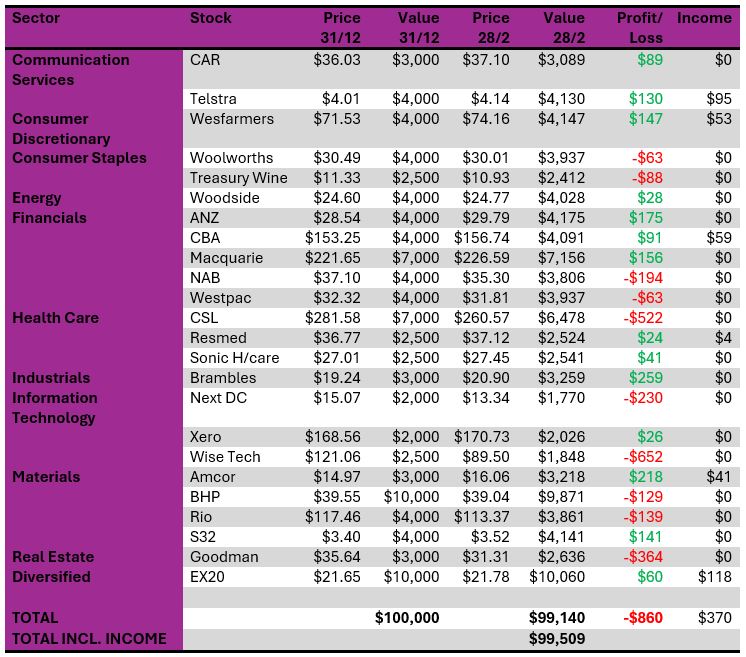The Australian share market retreated in February, giving up nearly all of January’s gain. An underwhelming company reporting season, concerns about trade and the geopolitical situation and subdued commodity prices took their toll, with the market falling by 3.8%. Our model portfolios were also lower, although the income portfolio outperformed as defensive stocks held up well.
At the beginning of the year, we updated our portfolios for 2025. There are two model portfolios – an income-oriented portfolio and a growth portfolio. The objectives, methodology, construction rules and underlying economic assumptions can be referenced here: (see: https://switzerreport.com.au/our-portfolios-for-2025/)
These are long-only model portfolios, and as such, they are assumed to be fully invested at all times. They are not “actively managed”, although adjustments are made from time to time.
In this article, we look at how they have performed so far in 2025. To do so, we will start by examining how the overall market has fared.
Small caps on top, defensive sectors doing better
The tables below show the performances in February and year to date of the components (large cap, mid cap, small cap etc.) and industry sectors that make up the Australian share market.
Small caps continue to outperform (in a relative sense), with the small caps index shedding 2.8% in February compared to the index for the top 20, which dropped by 4.1%. Year to date, the S&P/ASX Small Ordinaries Index (an index which tracks stocks ranked 101st to 300th by market capitalization size) is up by 1.7%.

With the industry sectors, the largest sector by market weight, financials, which makes up 33.8% of the overall S&P/ASX 200 index, gave up 4.4% in February. Year to date, it has shown a positive return of 1.4%.
Defensive sectors tended to do better in February, with consumer staples, utilities, industrials and communication services finishing in the green for the month. Health and information technology were hit hard, in part due to the performance of some key leading stocks. (CSL and Cochlear in health, WiseTech in IT).

Portfolio Performance in 2025
The income portfolio to 28 February has returned 2.04% and the growth-oriented portfolio has returned -0.49% (see tables at the end). Compared to the benchmark S&P/ASX 200 Accumulation Index (which adds back income from dividends), the income portfolio has outperformed by 1.43% and the growth portfolio has underperformed by 1.10%.

Income portfolio
The objective of the income portfolio is to deliver tax advantaged income whilst broadly tracking the S&P/ASX 200.
The income portfolio is forecast to deliver an income return of 4.3% (based on its opening value at the start of the year), franked to 71.2%.
The portfolio has a defensive orientation and a bias to yield style stocks. On a sector basis, the biases are fairly minor. It is overweight consumer services and utilities (in order to find income), and marginally underweight financials (particularly the major banks), given our view that Australian banks are expensive. It is underweight information technology (where there are very few medium yielding stocks). It is marginally overweight materials and energy.
In a bull market, we expect that the income portfolio will underperform relative to the broader market due to the underweight position in growth-oriented sectors and the stock selections being more defensive, and conversely in a bear market, it should moderately outperform.
In the month of February, the income portfolio performed strongly, thanks to the performances of Medibank, Suncorp, Telstra, APA and Charter Hall Group. While down 1.07% in the month, this was 2.72% better than the index. Year-to-date, it has outperformed the benchmark index by 1.43%.
No changes to the portfolio are proposed at this point in time.
The income-biased portfolio per $100,000 invested (using prices as at the close of business on 28 February 2025) is as follows:

₁ Suncorp return of capital of $3.00 per share, plus share consolidation of 1:0.8511 and special div of 22c
Growth portfolio
The objective of the growth portfolio is to outperform the S&P/ASX 200 market over the medium term, whilst closely tracking the index. The growth portfolio in 2025 is moderately overweight communication services, health care, materials and information technology. It is underweight financials (particularly the major banks), consumer discretionary, industrials, real estate and utilities.
A major inclusion is the Betashares Portfolio Diversifier, EX20, weighted at 10% ($10,000). This ETF invests on an index-weight basis in stocks outside the top 20, providing ready and diversified exposure to mid and small cap stocks.
In the month of February, the growth portfolio returned -3.87%, matching pace with the index which returned -3.79%. WiseTech and Goodman Group (the latter due to a sizeable capital raising) particularly impacted performance. Year-to-date, the portfolio has returned
-0.49%, underperforming the benchmark index by -1.10%.
No changes are proposed to the portfolio at this point in time.
Our growth-oriented portfolio per $100,000 invested (using prices as at the close of business on 28 February 2025) is as follows:

Important: This content has been prepared without taking account of the objectives, financial situation or needs of any particular individual. It does not constitute formal advice. Consider the appropriateness of the information in regards to your circumstances.

